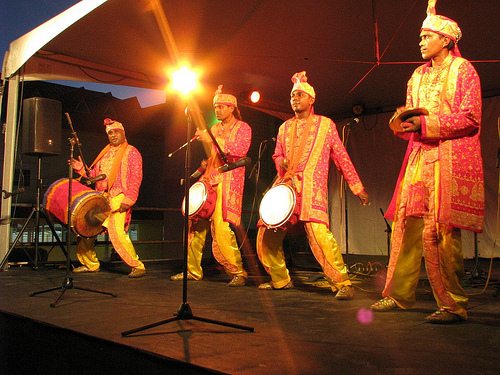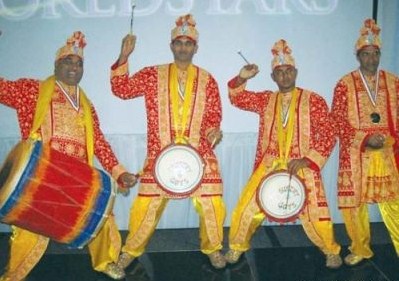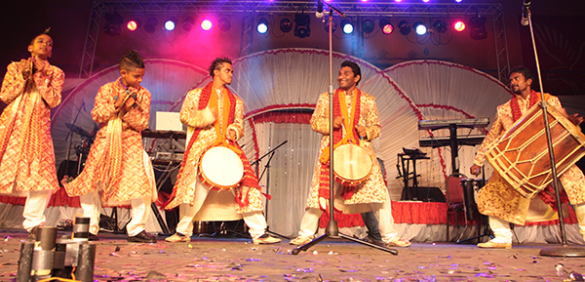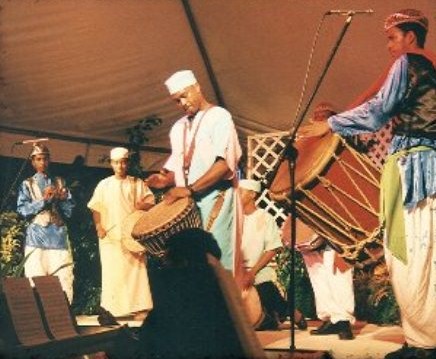Tassa Drums

|
Tassa
Drums
After last night and being so very wowed by the Tassa Drummers, I asked Bear, resting his sprained right ankle if he would download anything he could find on Itunes, success a good one. Then to find out some info on them. Tassa drums are found amongst Indo-Caribbean people. The word "tassa" comes from the Persian tash and Hindi tasha, which both mean "kettle drum". Aside from India itself, tassa groups can be found in Trinidad and Tobago, Florida, New York, Canada and various other places where the Indo-Caribbean communities are found.
 Construction: Traditionally, the tassa is made by tightly covering a clay shell with
goat skin; early tassa were covered in monkey skin as well. When ready to play,
the goat skin is heated by aid of a fire to tighten the head, making the pitch
higher. This process is called "standing it up". In this way, the pitch can stay
high for 20–30 minutes. Now tassa drums are even made by cutting an empty
coolant tank in half and attaching a synthetic drum skin to the top of it with
nuts and bolts, welding it shut. Synthetic drums do last longer and do not have
to be adjusted as frequently. Although synthetic drums last longer, they deviate
from the long standing tradition of clay and goatskin and do not sound as
well. Bass drums are constructed from a single piece of tree trunk, usually mango or cedar, but older, larger drums were made of the dense but light weight cottonwood tree which is rarely found today. The hollowed out trunk is covered on both sides by goat skins which are pulled tightly with rope. Different amounts of "massala" is placed in the insides of the skin to create a lower frequency resonation on the "bass" side hit with a stick, and a higher frequency resonation on the more "treble" side hit with the hand. The deep, booming sounds of bass drums can be heard for long distances.
 Playing tassa: When played in a tassa group, one tassa is the "cutter" and the other is the "fulley" or "fuller", as their role is to make the rhythm or "taal" sound more full. The fulley plays a steady rhythm and at a constant speed while the cutter plays the more intricate rhythms and improvises. A large bass drum, usually made from a mango tree trunk, is also played filling in a deep sound and in addition there is someone with jhanj or jhaal ( Hindi for brass "cymbals") playing in the group also. Tassa drumming can usually be found at a various Indo-Cultural events such as Hosay, Hindu weddings, or even parties and certain clubs.
 The rhythms are quite complex and each have many variations. Some basic hands are tikora, wedding hand, nagaara, chutney, bhangra, dingolay, soca, chau bola (Hindi for "four words", as this is a four-beat rhythm), kalinaa, khemta, and bhajan. Hosay (Muharram) festival rhythms include saada mahaatam, chalta mahaatam, teen choppa, and nabi sarwar. The tassa drums are played with sticks made from wild cane (called "chob", Hindi for cane sticks) or fiberglass. The sticks can either have very tightly wound masking tape at the top or the sap from a balata tree wound into a ball can form the head of a stick. When played, these pliant sticks are struck on the head of the drum and accomplish a unique sound because the flexibility of the stick is responsible for the roll rather than the regressive bouncing action of the head of the stick.

ALL IN ALL FANTASTIC LOUD AND VERY RHYTHMICALLY MOVING |
